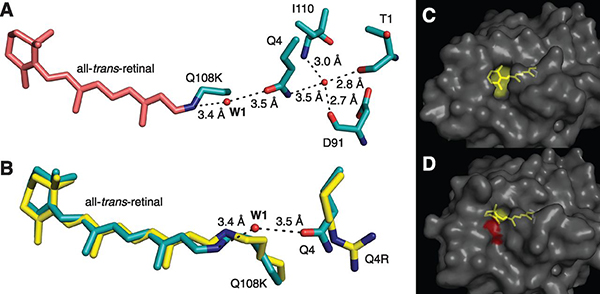The pigments in retinal photoreceptor cells absorb varying wavelengths of light, but the central chromophore, the molecule that actually absorbs the photon is identical. Its ability to tune the responsiveness comes from the association with other opsins giving an organism the ability to respond from the near ultraviolet all the way to far red. Interestingly, an article in Science by Wenjing Wang, Zahra Nossoni, Tetyana Berbasova, Camille T. Watson, Ipek Yapici, Kin Sing Stephen Lee, Chrysoula Vasileiou, James H. Geiger and Babak Borhan back in December demonstrates that you can generate “designer pigments” with a variety of applications through spectral tuning of the chromophore.
They way they went about this work was mutating human cellular retinol binding protein II (hCRPBII), a protein normally found in the gut that carries retinol. Retinol (with an “o”) is very similar to retinal (with an “a”), but hCRPBII does not carry retinal. So, they mutated hCRPBII so that it would bind and carry retinal (with an “a”). At this point, the research group could start altering amino acids in the site that bound retinal to change the electrostatic charge for retinal and in doing so, created a set of pigments that absorbed pigments at differing wavelengths. The really interesting thing is that there was no resulting substantial conformational change in retinal. Rather, what changes is the distribution of charge that alters the responsiveness to wavelength which is kind of surprising, to me at least. Its a pretty cool study and worth reading that may show the way to fabricating pigments with a variety of applications from transgenic work in optogenetics to labeling of specific cell classes to potential computational applications.
Image from: Tuning the electronic absorption of protein-embedded all-trans-retinal. Science. 2012 Dec 7;338(6112):1340-3. doi: 10.1126/science.1226135.
